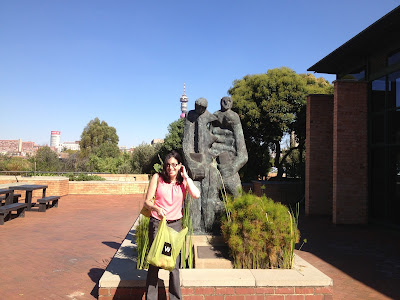 |
| Driving through Johannesburg on the way to Bara. |
Today we started the day off in the diabetes clinic. Walking in, we were greeted by Lareto and Lavundo, two of the four dedicated diabetes educators, on their way to the wards to evaluate the inpatients with diabetes. They usually spent 1-2 hours a day meeting new patients; reviewing their in-hospital blood glucose values, providing basic teaching, and encouraging inpatients to join the diabetes education classes.
Diabetes education classes are held 3 days a week and are taught in 6-7 different languages, including Xhosa (there are 11 officially recognized languages in South Africa!) Xhosa is spoken by about 18% of the population and has quite distinctive click consonants. Listen to the You Tube clips of the Xhosa clicks I posted, if you are interested.
It’s quite amazing to be able to communicate in so many languages! I struggle to be able to communicate well with patients in my second language, Spanish. I often rely on the translator phones.
We spent time with two of the consultants (the term for the US equivalent of attending physician, Dr. Bruno Pauly and Dr. Sindeep Bhana learning about how the diabetes clinic is run, the evolution of outreach programs in the surrounding communities, and the metrics the clinic uses in their clinic quality improvement initiatives (one of my areas of interest!)
We then headed to meet the team after their post-intake rounds. At Bara, the endocrinologists also spend much of their time attending on the general medicine wards, admitting every 5 days. In contrast, at Penn the endocrinologists spend the majority of their time working in the outpatient clinics and as an attending physician on the endocrine consult service.
We then went to the maternal diabetes clinic. There are over 2,000 deliveries a month at Baragwanath (24,000 a year compared to 7-10,000 at Penn), so the clinic is quite busy!
 |
| Sister Nomthandazo Mataboge, head Matron of the maternity ward and a diabetes educator |
 |
| Patients waiting to be seen by the consultant. |
We saw approximately 20 patients with Dr. Huddle, the consultant (attending physician), and Andrew and Mercy - two of the registrars (the US equivalent of resident)
Most of the patients had type II or gestational diabetes (a
majority of them likely were previously undiagnosed type II diabetics), but we
also saw one patient with type I diabetes, and two patients with thyroid conditions. We also evaluated a patient with a pheochromocytoma, refer to my next blog
posting of the case of the day if you are interested in the clinical details of
this fascinating case!
 |
| The endocrine team consulting with a patient. |
In Dr. Huddle's experience, patients with type II diabetes
typically present to Bara in the second trimester for prenatal care. Newly diagnosed
gestational diabetic patients are admitted to the hospital for several days to
achieve adequate glycemic control and receive intensive diabetes education. While in the
hospital, and during any subsequent clinic visits and hospital admissions, patients bring their glucometers and check their own finger sticks.
Pregnant patients with diabetes are seen in the outpatient clinic by OB and diabetes consultants every two weeks
until 32 weeks and thereafter weekly. One of the patients came by taxi from an hour away, as Baragwanath guarantees free care for pregnant women. Patients who achieve an HbA1C <7% are
usually induced at 37 weeks and patients with worse control are induced about a week
earlier.
After Dr. Huddle reviewed the deliveries from the prior week with the other consultant, Dr. Nasrin Goolam-Mahyoodeen, Kershlin and one of the OB registrars took us to see the maternity wards.
 |
| Ilona, Dr. Mandel, and one of the OB registrars walking to the maternity wards |
 |
| OB triage/admissions, patients waiting to be evaluated. |
 |
| Walking through the high risk pregnancy ward. |
There are approximately 30 C-sections a day, about 25% of patients and 50% of patients with diabetes, so the surgery theatre is quite busy!
 |
| The list of C-sections |
AFTERNOON
After leaving the maternity wards, Kershlin took us to the University of the Witswatersrand main campus, on our way to the medical school.
 |
| Ilona and Kershlin |
 |
| The high was 81F (27C), a dip in the campus pool would be nice! |
We then drove to the Wits Medical School campus, where I was scheduled to give a talk to the endocrine division. The medical school is one of six medical schools in South Africa and provides approximately 500 undergraduate degrees (considered graduate degrees in the US) in Medicine, Dentistry, Nursing, Pharmacy, Physiotherapy, and Occupational therapy yearly. Click on the link below if you are interested in learning more about Wits Medical School.
 |
| Dr, Mandel on the Wits Medical Campus |
 |
| Dr. Mandel and Ilona at the Wits History of Medicine Museum |
The topic of my presentation was ipilimumab-associated hypophysitis. The drug is on trial for compassionate use in some parts of SA, but not at Bara. This is a new and quite interesting presentation of autoimmune hypophysitis and may lead to greater insights about pituitary autoimmunity. During the talk I provided background about the presentation and management of hypophysitis before discussing the mechanism of action, therapeutic uses, and endocrine immune related adverse events (IrAEs) of ipilimumab. I then discussed our experience with these patients at Penn and how we co-manage them with the oncology division. Interestingly, as we walked down the hall Dr Shires noted that the talk right underneath his talk (for a joint endocrine/heme lecture) was a lecture on therapeutic uses of ipilimumab!!
Our division is definitely looking forward to Kershlin coming to Penn and presenting some patient cases of endocrine diseases that we have less experience with in Philadelphia.







Diabetes is a disease in which there are high blood sugar levels. Diabetes can cause many complications. The major long-term complications relate to damage to blood vessels. Diabetes doubles the risk of cardiovascular disease and about 75% of deaths in diabetics are due to coronary artery disease. Other "macrovascular" diseases are stroke, and peripheral artery disease. There are more than 180 million people are affected by diabetes in all over the world and this number is increasing day by day. Patient should consultant for diabetes treatment
ReplyDelete